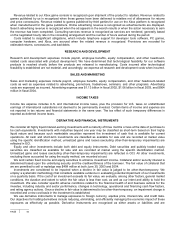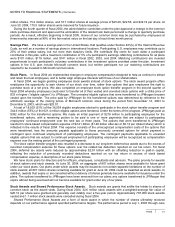Microsoft 2004 Annual Report Download - page 42
Download and view the complete annual report
Please find page 42 of the 2004 Microsoft annual report below. You can navigate through the pages in the report by either clicking on the pages listed below, or by using the keyword search tool below to find specific information within the annual report.
PAGE 42
ALLOWANCE FOR DOUBTFUL ACCOUNTS
The allowance for doubtful accounts reflects our best estimate of probable losses inherent in the accounts receivable
balance. We determine the allowance based on known troubled accounts, historical experience, and other currently
available evidence. Activity in the allowance for doubtful accounts is as follows:
(In millions)
Year Ended June 30
Balance at
beginning of period
Charged to costs
and expenses
Write-offs
and other
Balance at
end of period
2002 $174 $192 $(157) $209
2003 209 118 (85) 242
2004 242 44 (120) 166
INVENTORIES
Inventories are stated at the lower of cost or market, using the average cost method. Cost includes materials, labor, and
manufacturing overhead related to the purchase and production of inventories. We regularly review inventory quantities
on hand, future purchase commitments with our suppliers, and the estimated utility of our inventory. If our review indicates
a reduction in utility below carrying value, we reduce our inventory to a new cost basis.
PROPERTY AND EQUIPMENT
Property and equipment is stated at cost and depreciated using the straight-line method over the shorter of the estimated
life of the asset or the lease term, ranging from one to 15 years. Computer software developed or obtained for internal use
is depreciated using the straight-line method over the estimated useful life of the software, generally three years or less.
GOODWILL
Goodwill is tested for impairment on an annual basis as of July 1, and between annual tests if indicators of potential
impairment exist, using a fair-value-based approach. No impairment of goodwill has been identified during any of the
periods presented.
INTANGIBLE ASSETS
Intangible assets are amortized using the straight-line method over their estimated period of benefit, ranging from one to
ten years. We evaluate the recoverability of intangible assets periodically and take into account events or circumstances
that warrant revised estimates of useful lives or that indicate that impairment exists. All of our intangible assets are subject
to amortization. No impairments of intangible assets have been identified during any of the periods presented.
NOTE 2 UNEARNED REVENUE
Unearned revenue is comprised of the following items:
Volume licensing programs – Represents customer billings, paid either upfront or annually at the beginning of each
billing coverage period, which are accounted for as subscriptions with revenue recognized ratably over the billing
coverage period.
Undelivered elements – Represents free post-delivery telephone support and the right to receive unspecified
upgrades/enhancements of Microsoft Internet Explorer on a when-and-if-available basis. The amount recorded as
unearned is based on the sales price of those elements when sold separately and is recognized ratably on a straight-line
basis over the related product’s life cycle. The percentage of revenue recorded as unearned due to undelivered elements
ranges from approximately 15% to 25% of the sales price for Windows XP Home, approximately 5% to 15% of the sales
price for Windows XP Professional, and approximately 1% to 15% of the sales price for desktop applications, depending
on the terms and conditions of the license and prices of the elements. Product life cycles are currently estimated at three
and one-half years for Windows operating systems and two years for desktop applications.
























